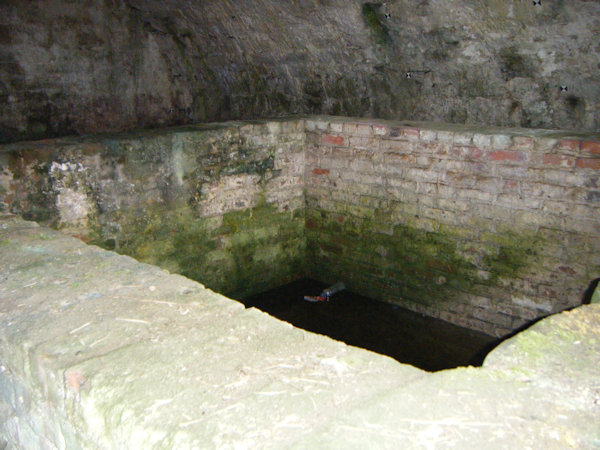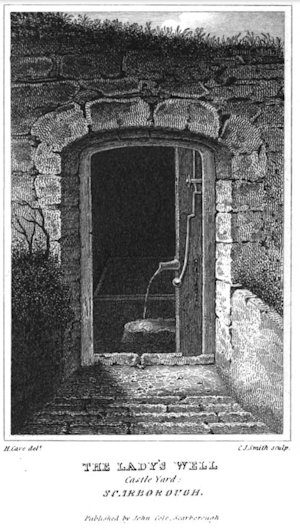 |
Dedication: Saint Mary the Virgin Location: Scarborough Castle Coordinates: 54.28747, -0.38622 Grid reference: TA051891 Heritage designation: Scheduled monument |
HOME - ENGLAND - NORTH RIDING
 |
Dedication: Saint Mary the Virgin Location: Scarborough Castle Coordinates: 54.28747, -0.38622 Grid reference: TA051891 Heritage designation: Scheduled monument |
For at least a thousand years, there has been a chapel of St Mary at this location. It was built on the site of a Roman signal station, although it was, shortly after its construction, destroyed during the late 11th century. The chapel was, however, rebuilt in the 12th, and later in the 14th centuries; it was quite a substantial structure, and had, at least during the 16th century, a leaden roof. Today, all that remains of this church is its crypt, within which Our Lady's Well is (according to some sources, at least) located.
The earliest mention of what may be this well that I have been able to find dates from 1538, and appears in a survey of the "Castell off Scarburgh" that was made by Sir Marmaduc Constable and Sir Rauff Ellerker:
|
Besyds the sayd towr towarde the est is a large playne called the CASTYLL GARTH conteynynge in lenght cccciijXX yardys, in brede ccxl yards, and wythin the same garth is a praty chapell of o'r Lady, and cov'd wyth leade, and besyde the same chapell a fayre well. |
Almost certainly, this "fayre well" is the deep well that is located a few metres south-west of the chapel. Several sources today claim that this deep well is the original Lady Well, which could well be true; whilst this survey does not explicitly state whether this is the holy well or not, the fact that the "fayre well" is not named as the Lady Well indicates that may simply have been an ordinary practical well that possessed no name. Of course, as this survey was completed during the height of the Reformation, when the cult of holy wells was greatly suppressed, there may be other reasons for the exclusion of the Lady Well from this report.
Irrespective of the original location of the Lady Well, there was no doubt by the 18th century, at least, that the holy well was the large tank located in the crypt; in fact, I have found absolutely no question of its location being anywhere else, until, of course, the 20th century. The sizeable brick construction (no photograph can do its magnitude justice) that currently houses this water supply was built at some point during the 18th century, probably to provide a supply for the nearby barracks. However, there was almost certainly already something there prior to this brick structure: in around 1746, the man who was supervising the building of the barracks dug a trench around whatever was there before in an attempt to discover the source. The well was certainly well known by the late 18th century, as several experiments had already been performed on the water of it by the 1790s, and the source of the water (which has always, it seems, been a great mystery) was investigated and pondered upon. Thomas Hinderwell, in his History and Antiquities of Scarborough and the Vicinity (1798), after describing the well and its attributes, mentioned a "facetious circumſtance" that had brought the Lady Well "into eſtimation":
|
The late maſter of the Coffee Houſe, (Mr. William Cockerill) a perſon of great humour and ingenuity, having been often ſolicited by the company who frequented his houſe, to introduce Briſtol Water to his table; ſubſtituted the Caſtle Water in its place. The deception was carried on with great dexterity. -- The wax upon the corks bore the impreſſion of the Briſtol ſeal. -- A freſh importation was pretended to be made every ſeaſon, warranted from the fountain-head, and the connoiſſeurs pronounced it genuine. But the ingenuity of the contriver failed him in an unguarded hour. He had, in a convivial party, taken too much wine, and in the confuſion of an intoxicated moment, the Briſtol ſeal was applied to a bottle of Sherry, which was haſtily ſent up to the table, even before the wax had time to cool. This unlucky circumſtance occaſioned a diſcovery; and the maſter of the Coffee-houſe not only received a ſevere reprimand for the impoſition; but was obliged ever after, as its reputation was eſtabliſhed, to ſupply the water gratis. |
James Schofield, in the 2nd edition of the Scarborough Guide, which was published in 1796, described the well as appearing "under an arched vault in the caſtle-yard", which, he claimed, was "by ſome imagined a cellar", but by others "a conſecrated ſpring", and, as evidence for the latter, he noted that it was "ſtill diſtinguiſhed by the name of the Lady's Well". He went on to describe the site, along with details of experiments and the investigations that had taken place several decades prior:
|
Its appearance in ſuch a ſituation, is at any rate extraordinary. Its diſtance from the cliff precipice, is about twenty-five yards; three hundred feet in perpendicular height, from the ſea; and with no high lands above, or on its level, but at a mile's, or more, diſtance; and not the leaſt probability of being ſupplied from any one of them. This reſervoir, however fed, contains about forty tons of water; and in the moſt remarkable dry years, particularly that of 1765, when moſt of the wells and ſprings, all the country over, were dried up; this had no diminution of its uſual quantity in other years. By experiments, it has been found to weigh lighter by one ounce, in the Wincheſter gallon, than any other water in this country. An engineer, who ſuperintended building the barracks, and other military works, about the year 1746, had the curioſity to ſearch for what ſource Lady's Well was ſupplied by. He accordingly dug round it in every direction to a conſiderable depth, and found that channels, drains, or conveyances were laid under ground, ſo as to carry whatever rain-water ſhould fall on the area of the caſtle-hill to it. ... This water, deemed excellent for various uſes, is held in high eſteem. |
It has been stated that this well was once believed to possess healing powers, and, although most of this seems to be speculation, it could well be true. In 1863, a book entitled Views of Scarborough, which was published by T. Nelson and Sons, claimed that "it was anciently supposed to possess healing virtues". R. C. Hope, in The Legendary Lore of the Holy Wells of England (1893), also asserted that "medicinal properties were formerly ascribed to the waters of this well".
At some point, probably in the 19th century, a pump was installed that partially covered the well, which was described by R. C. Hope as being "hideous-looking", though "possibly useful". Although initially it may sound as though this pump would have been located over the deep well outside the chapel, a drawing by John Cole that was published in A Series of Cabinet Views, from 1825, indicates something different.
 |
Today, the Lady Well survives intact inside the crypt of the chapel. When I visited in the March of 2025, the tank was clearly leaking, but it still held a large quantity of water.
|
Access: The crypt is not ordinarily open to the public, but English Heritage are happy to open it upon request. |
Copyright 2025 britishholywells.co.uk